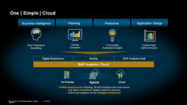SAP Asset Analytics
Filter By
Browse By
- SAP Analytics and AI
- SAP Application Development and Integration
- All SAP Application Development and Integration
- SAP ABAP
- SAP ABAP Development Tools
- SAP ABAP Test Cockpit
- SAP API Management
- SAP BAPI
- SAP Basis
- SAP BRF
- SAP Business Application Studio
- SAP CMS
- SAP Design Studio
- SAP Development Tools
- SAP DevOps
- SAP EAI
- SAP EDI
- SAP Extension Suite
- SAP Fiori
- SAP Fiori Elements
- SAP Integration Suite
- SAP Low Code Application Development
- SAP Low Code Automation
- SAP Netweaver
- SAP Release Management
- SAP UI5
- SAP Web Application Server
- SAP Web IDE
- SAP Business Process Management
- SAP Center of Excellence
- SAP CIO
- SAP Customer Experience
- SAP Data and Data Management
- All SAP Data and Data Management
- SAP BW
- SAP BW/4HANA
- SAP Crystal Reports
- SAP Data Archiving
- SAP Data Center
- SAP Data Governance
- SAP Data Integration
- SAP Data Migration
- SAP Data Quality
- SAP Data Services
- SAP Data Strategy
- SAP Data Visualization
- SAP Data Warehouse Cloud
- SAP DMS
- SAP Document Control
- SAP EIM
- SAP ETL
- SAP ETL Tools
- SAP HANA
- SAP HANA Administration
- SAP HANA Deployment Infrastructure
- SAP HANA Studio
- SAP Master Data
- SAP Master Data Governance
- SAP MDM
- SAP Enterprise Architect
- SAP Enterprise Asset Management
- SAP ERP
- SAP Finance
- All SAP Finance
- SAP Accounting
- SAP AR AP
- SAP Asset Accounting
- SAP Billing Systems
- SAP BPC
- SAP BRIM
- SAP Cash Management
- SAP Central Finance
- SAP Controlling
- SAP COPA
- SAP Cost Center Accounting
- SAP Currency Risk
- SAP e-invoicing
- SAP FICO
- SAP Finance Automation
- SAP Advanced Financial Closing
- SAP Financial Consolidation
- SAP Financial Planning
- SAP FX Risk
- SAP General Ledger
- SAP Global Tax Management
- SAP Hyperion
- SAP Order to Cash
- SAP Payment Processing
- SAP Profitability Analysis
- SAP Rebate Management
- SAP S/4HANA Finance
- SAP SWIFT Compliance
- SAP Treasury Management
- SAP Universal Journal
- SAP Governance Risk and Compliance
- SAP Human Capital Management
- SAP Intelligent Technologies
- SAP Platform and Technology
- All SAP Platform and Technology
- SAP Business Technology Platform
- SAP Cloud
- SAP Cloud Connector
- SAP Cloud Integration Platform
- SAP Cloud Migration
- SAP Cloud Platform
- SAP Cloud Providers
- SAP Cloud Strategy
- SAP Digital Signature
- SAP Container Platform
- SAP HANA Enterprise Cloud
- SAP Digital Asset Management
- SAP Smart Forms
- SAP HEC
- SAP Digital Integration Hub
- SAP Hyperscalers
- SAP Infrastructure
- SAP Messaging
- SAP Quality and Testing
- SAP Security
- SAP Spend Management
- SAP Supply Chain Management
- All SAP Supply Chain Management
- SAP APO
- SAP Asset Management
- SAP Business Network
- SAP Digital Manufacturing Cloud
- SAP Digital Twin
- SAP EWM
- SAP IBP
- SAP Inventory Management
- SAP Label Printing
- SAP Logistics
- SAP Manufacturing
- SAP Manufacturing Automation
- SAP MES
- SAP MII
- SAP MM
- SAP MRO
- SAP MRP
- SAP Order Management
- SAP Plant Maintenance
- SAP PLM
- SAP Production Planning
- SAP S&OP
- SAP SD
- SAP SPM
- SAP Supply Chain Planning
- SAP Track and Trace
- SAP Transportation Management
- SAP System Administration
Predictive Asset Analytics is the use of statistical modeling, data mining techniques, machine learning, and digital twin technologies to make predictions about future outcomes. A cloud deployment or cloud native solution is required to gain insights from sensor data and engineering simulations. With advances in data storage and loT sensor technology organizations can learn about each asset’s individual performance to predict asset productivity.
Improving reliability, performance, and safety are top priorities for organizations today. But organizations are also focusing on controlling costs and maximizing value from existing investments by supporting predictive maintenance and service. Predictive asset analytics is a solution for end-to-end asset management to provide early warning signals and give a diagnosis of equipment long before failure.
Key Capabilities of SAP Predictive Asset Insights include:
- A 360 view of assets: A holistic view of the asset model with a single predictive tool increasing visibility into master, transactional, performance, and loT data sensor data.
- Intuitive and scalable machine learning: Ability to detect abnormalities and predict failure without data scientist intervention, extending the intelligence of predictive maintenance by machine learning capabilities.
- Advanced analytics: Gain insights into failure modes and leading indicators by benefiting from purpose-made analytical capabilities augmented with predictive asset intelligence.
- Digital twin simulations: Apply ANSYS digital twin technology to analyze assets in action and over time in a live environment where engineering simulations support virtual sensors.
Predictive Asset Analytics is the use of statistical modeling, data mining techniques, machine learning, and digital twin technologies to make predictions about future outcomes. A cloud deployment or cloud native solution is required to gain insights from sensor data and engineering simulations. With advances in data storage and loT sensor technology organizations can learn about each asset’s individual performance to predict asset productivity.
Improving reliability, performance, and safety are top priorities for organizations today. But organizations are also focusing on controlling costs and maximizing value from existing investments by supporting predictive maintenance and service. Predictive asset analytics is a solution for end-to-end asset management to provide early warning signals and give a diagnosis of equipment long before failure.
Key Capabilities of SAP Predictive Asset Insights include:
- A 360 view of assets: A holistic view of the asset model with a single predictive tool increasing visibility into master, transactional, performance, and loT data sensor data.
- Intuitive and scalable machine learning: Ability to detect abnormalities and predict failure without data scientist intervention, extending the intelligence of predictive maintenance by machine learning capabilities.
- Advanced analytics: Gain insights into failure modes and leading indicators by benefiting from purpose-made analytical capabilities augmented with predictive asset intelligence.
- Digital twin simulations: Apply ANSYS digital twin technology to analyze assets in action and over time in a live environment where engineering simulations support virtual sensors.
Benefits of SAP Predictive Asset Insights are:
- Improves service effectiveness
- Lowers maintenance costs
- Increases asset availability
Vendors partners for predictive asset analytics are: SAP , PWC, KCT
Key Considerations for SAPinsiders are:
- Advanced Analytics and Performance Intelligence. In the recent state of the market for process automation, SAPinsiders indicated that intelligent automation and process intelligence are key capabilities they are planning to build in the next two years. This analyst insight explores some critical aspects to be aware of on your path to develop these capabilities.
- Achieve Business Clarity with Process Intelligence. Process intelligence provides an understanding of where process deficiencies exist and where leverage opportunities reside. SAPinsider sat down with Shoeb Javed, Chief Strategy and Product Officer for software testing firm Worksoft Inc., to discuss the latest Achieve Business Clarity with Process Intelligence process intelligence trends.
- Digital twins are on the Rise to Mitigate Risk. Companies are searching for greater efficiencies to improve operational efficiencies and be more resilient. In this analyst insight learn what digital twins are, how they work, how they have evolved, and benefits that they can bring to your organization. Optimization is where digital twins excel to test contingency plans and build resilience.
855 results
-

 Premium
Premium
Reconcile FI-AA with FI-GL After Fixed Asset Data Takeover
Reading time: 10 mins
Learn five steps to reconcile the Asset Accounting sub-ledger with FI-GL after you complete the initial go-live implementation when you bring over the asset data from your legacy system into your SAP system. Key Concept Fixed asset legacy data takeover is the process of loading asset data from a previous system into SAP’s Asset Accounting...…
-

 Premium
Premium
Dodd-Frank Act: Standardize Risk Management Processes with SAP BusinessObjects Risk Management 10.0
Reading time: 17 mins
Ensure that your enterprise’s risk management procedures comply with the Dodd-Frank Act’s requirements pertaining to the management of systemic risks by using SAP BusinessObjects Risk Management 10.0. It supports the five phases of risk management. Key Concept The Dodd-Frank Act was signed into law in July 2010 in response to the 2007 US financial crisis....…
-

 Premium
Premium
How to Add Custom Fields to a Fixed Asset
Reading time: 19 mins
Enhance fixed asset master data in your SAP ERP system by activating a user exit and creating a custom screen. You then can track additional characteristics of a fixed asset to report on and comply with industry- or country-specific requirements. Key Concept User exits allow users to add functionality to SAP’s standard program logic without...…
-
-

 Premium
Premium
Web-Based Asset Accounting with mySAP Financials
Reading time: 4 mins
The Fixed Asset Accounting module of mySAP Financials gives you access to end-user transactions and reports via the Web. This makes possible applications such as Web-based asset procurement, employee self-service updates to an asset’s physical location, and downloading asset numbers to a hand-held bar-coding or scanning device. The mySAP.com version of R/3 makes a number...…
-

 Premium
Premium
Spotlight: Fixed Asset Revaluation with SAP’s RAAUFW02 Program
Reading time: 7 mins
Revaluation of fixed assets is a common business event. Maybe your organization is going through a merger or acquisition, or maybe you are involved in a year-end fixed asset revaluation? Whatever the case may be, you want to make sure that you are following best practices for a fixed asset revaluation. What are the best...…
-

SAP S/4HANA Embedded Analytics
Reading time: 19 mins
Panelists: Dmitry Kuznetsov, BI Consulting; Andrei Zhakhavets, Independent Consultant Sponsor: BI & HANA 2018 Read this Q&A transcript to learn about the embedded BI content delivered in SAP S/4HANA, such as analytic models and SAP Fiori tiles. If your organization is considering, evaluating, or planning the move to SAP S/4HANA, get answers to key topics, such...…
-

 Premium
Premium
Use SAP ECC 6 to Fulfill Accounting Requirements for Assets Impairment
Reading time: 12 mins
FinancialsLearn some configuration tips to help you overcome challenges in recoding the impairment loss on assets in an SAP system. Key Concept Asset impairment is a key requirement of various legal regulations to ensure that an organization’s financial statements show the realistic value of its assets. Proper accounting of asset impairment in the books is...…
-
-

How to Simplify Access to Analytics for Everyone
Reading time: 6 mins
Simply migrating to the cloud is no longer enough—companies must be familiar with cloud analytics in order to extract meaningful information from massive volumes of data. For companies beginning their cloud analytics journey with an existing SAP BusinessObjects BI deployment, the author of this article recommends taking a hybrid approach to integrate SAP Analytics Cloud…
-

- SAP Asset Management
 Premium
Premium
SAP Asset Performance Management for Circular Manufacturing
Reading time: 4 mins
The manufacturing industry is a major contributor to carbon emissions, accounting for around 20 percent of global emissions. These emissions are primarily caused by energy usage during the manufacturing process. However, new approaches to designing, producing, and disposing of goods can reduce waste by eliminating it from products and processes, as well as by recycling…
-

Harness IoT and Big Data to Break Down Silos in Manufacturing
Reading time: 13 mins
In a digital supply chain, design, manufacturing, asset management, and finished products all come together in an uninterrupted, real-time loop to meet customer expectations for immediacy and customization. To achieve this, formerly siloed domains and processes must come closer together and become agile enough to meet individual demands. Learn how product design, manufacturing, and asset…
Become a Member
Unlimited access to thousands of resources for SAP-specific expertise that can only be found here.
Become a Partner
Access exclusive SAP insights, expert marketing strategies, and high-value services including research reports, webinars, and buyers' guides, all designed to boost your campaign ROI by up to 50% within the SAP ecosystem.
Upcoming Events
Related Vendors
Your request has been successfully sent


